One thing we can absolutely guarantee on your trip to Hawaii: you won’t run out of delicious fruit to try. From pineapples to mangosteens, this guide will tell you everything you need to know about Hawaiian fruit and how to enjoy eating like a local.
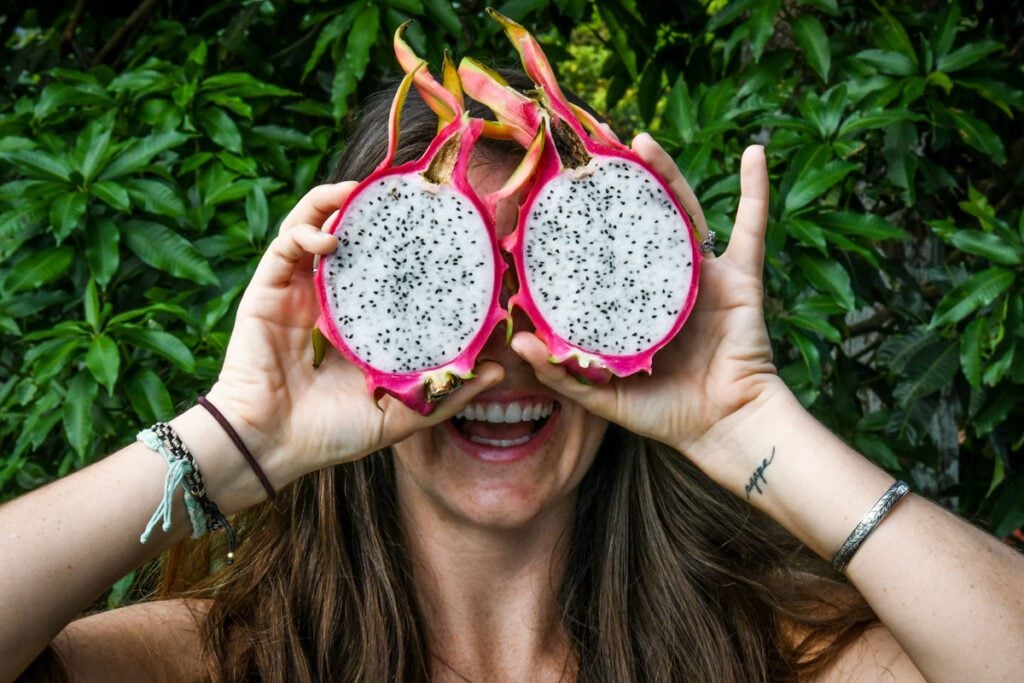
Take a look at any Hawaiian postcard and you’re likely to spot images of vibrant, fresh fruit dangling casually from trees. But, did you know that these exotic fruits weren’t always a staple in Hawaii?
When Polynesian settlers first arrived, they (thankfully!) brought with them a handful of fruit crops which, quite literally, planted the seeds for Hawaiian fruit culture.
You might find that knowing the history of a food adds a whole new level of adventure for your taste buds!
Our favorite Hawaiian fruits to try
If you need to narrow down your list, here are our personal favorites and recommendations:
- Passionfruit (lilikoi)
- Pineapple
- Apple banana
- Mango
- Coconut
- Mangosteen
- Papaya
- Guava
Other info on Hawaiian fruit
1. Passionfruit
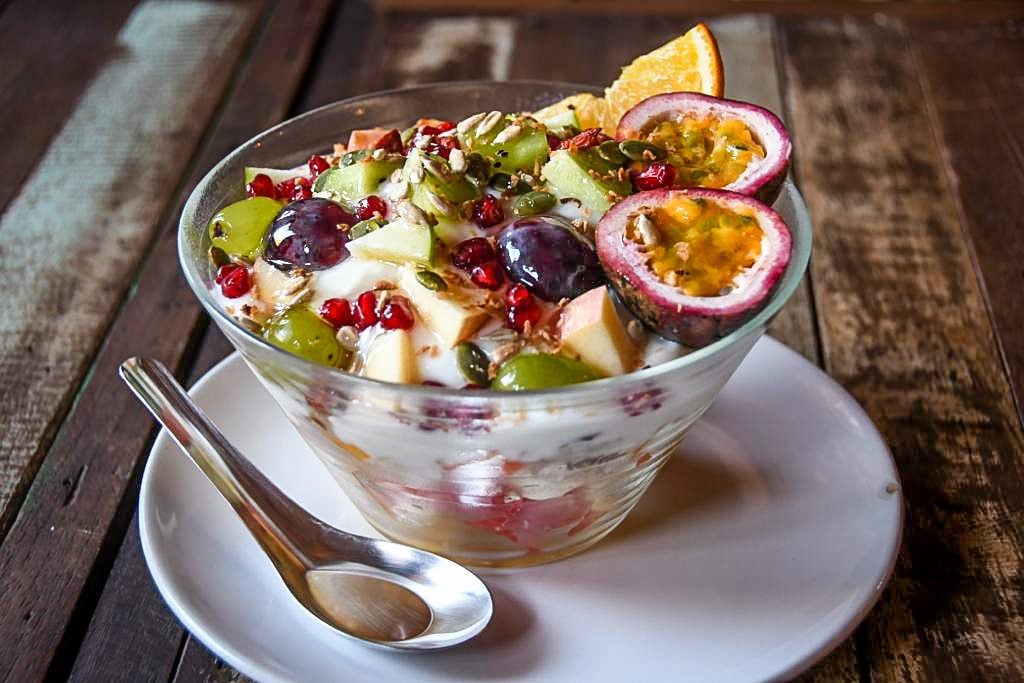
- Name in Hawaii: lilikoi
- Tastes like: tangy and tart with a unique, tropical flavor reminiscent of a sour pineapple
- Texture: the gooey texture of the fruit surrounding several light and crunchy seeds can be off putting to some
- Season: June – January
With a hard purple exterior, passionfruit looks completely different when cut open to reveal the golden, gooey fruit with many black (edible) seeds.
Passionfruit is one of our favorites! We love eating it straight from the shell with a spoon or mixed with plain (or vanilla) yogurt.
You’ll find lilikoi flavored everything around Hawaii: ice cream, jam, lemonade, smoothies, donuts, and even cocktails. Try ‘em all!
Tip: Even if you’re not big on the fruit’s texture, try it as a flavor instead and we think you’ll become a fan!
2. Pineapple
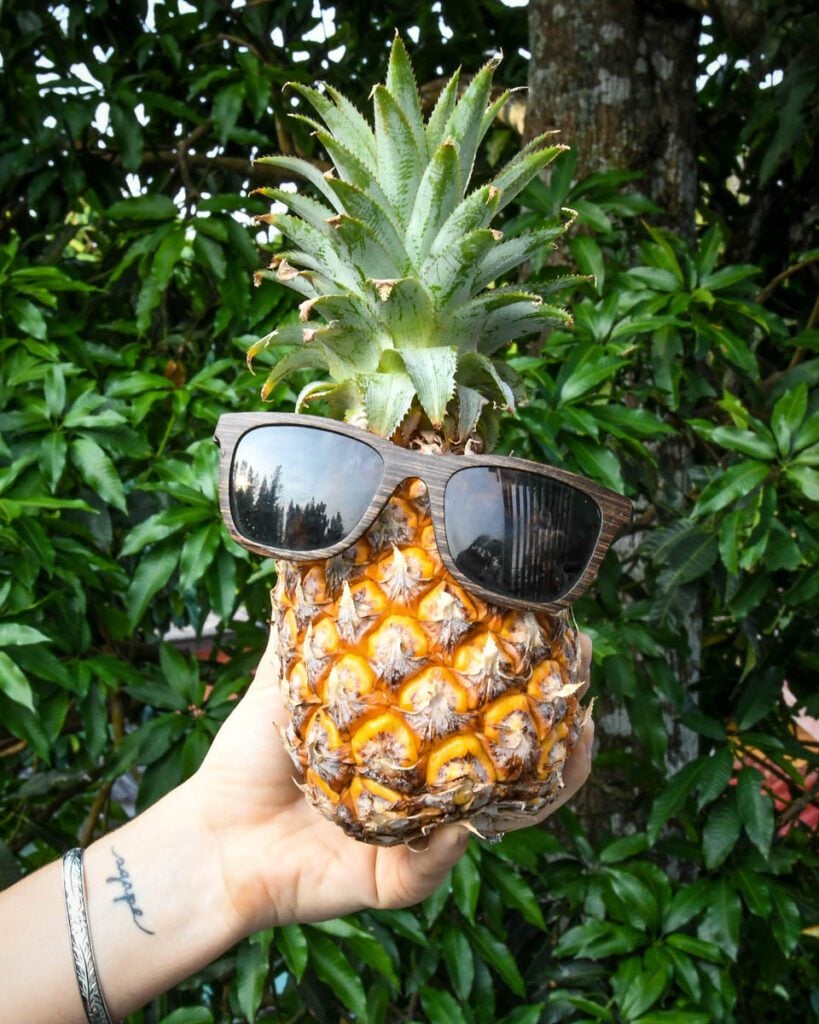
- Name in Hawaii: Hala kahiki
- Tastes like: an equal mix between tangy and sweet
- Texture: juicy, but also resembles a meat-like texture
- Season: year – round
Despite its tough and spiky exterior, pineapple is well worth the effort. From its vibrant color to its burst of flavor, pineapple is an iconic part of Hawaiian culture.
Visit any local market or roadside stand and you’ll be able to find this popular fruit in Hawaii. In most circumstances, it’ll be chopped up for you so you don’t even have to do the hard part.
Pineapple is a crowd-favorite because it is so versatile — eat it alone, throw it in a smoothie bowl or … dare we say … sprinkle it on a slice of pizza!
3. Breadfruit
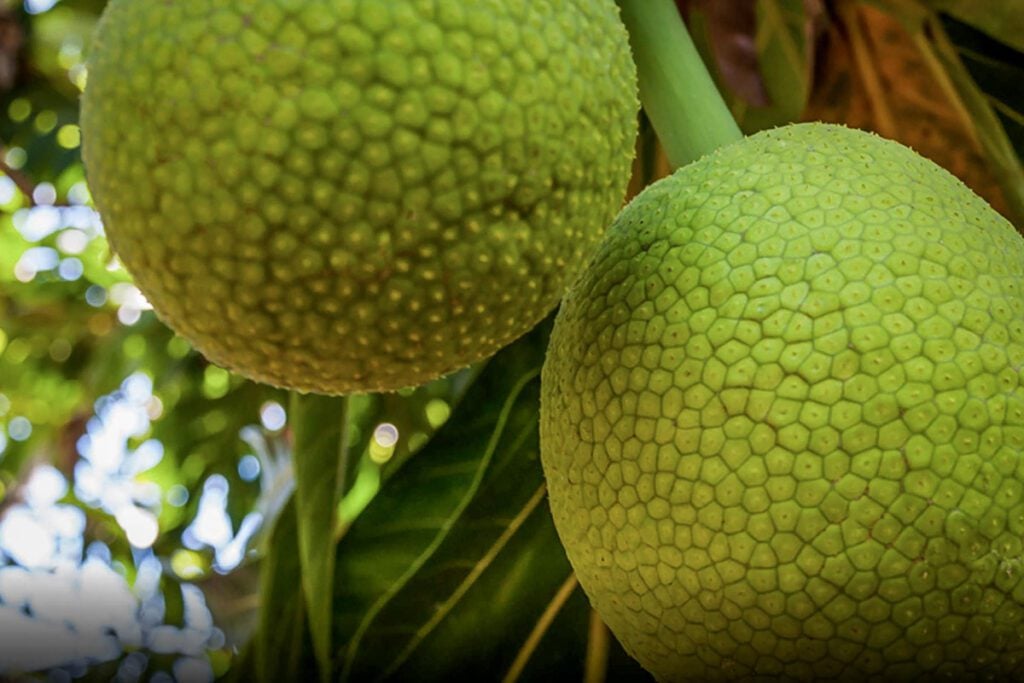
- Name in Hawaii: ‘Ulu
- Tastes like: starchy like a potato with sweeter, nuttier undertones
- Texture: similar to that of a boiled potatoes, ‘ulu is a bit pasty when ripe
- Season: year-round
Breadfruit seems like it came from a science-fiction novel with its unique, alien-like appearance. With its large exterior covered in bumpy green skin, this fruit might seem a bit intimidating, but don’t let its appearance fool you — there is deliciousness within.
Due to its versatility, this fruit is particularly popular in Hawaiian dishes and you’ll find it everywhere: in curries, fried into chips, or even tossed in fresh salads.
Tip: For a twist on the traditional Hawaiian poke dish, add ‘ulu!
4. Coconut
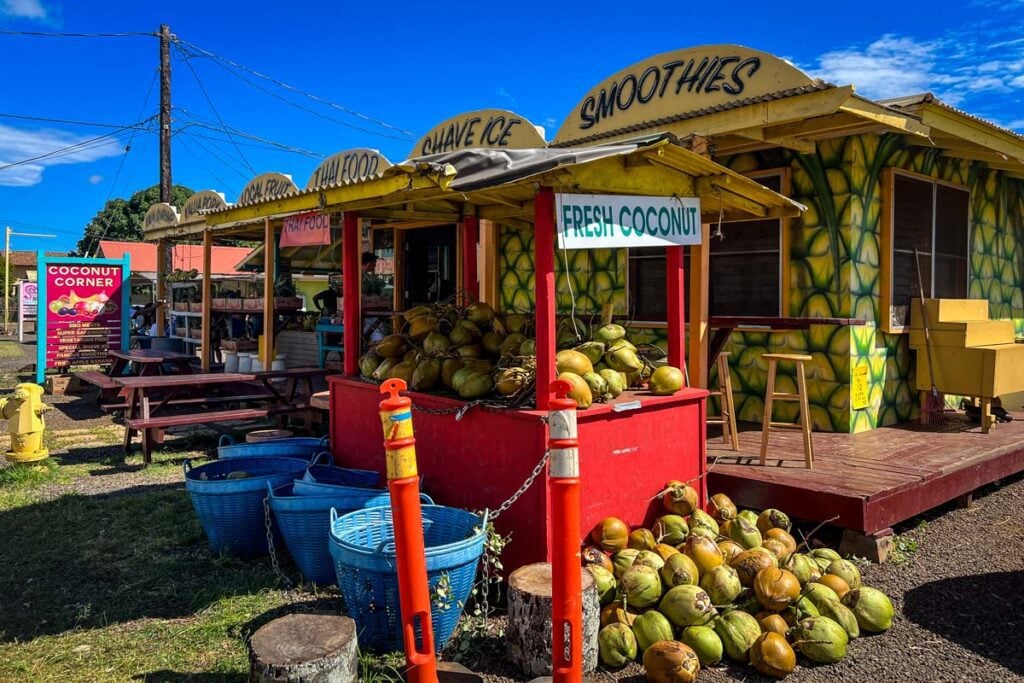
- Tastes like: both the water and meat have a sweet, tropical taste
- Texture: the coconut meat has a jellylike texture that is slightly chewy
- Season: year-round
Fresh coconuts are a Hawaiian staple. They grow in abundance and you can easily spot them hanging lazily from palm trees as you drive along the coastal roads.
To enjoy a coconut, visit a local market and have the vendor open it up for you. They are often served cold and the refreshing, sweet water is perfect for a sunny day.
Not only does coconut water taste good, it’s also packed with electrolytes. You might even try a coconut cocktail so you can hydrate while you indulge.
After you finish the water, take a spoon and scoop out the meat. If the coconut is ripe, the meat will peel off easily, whereas immature fruit might take a little more effort.
Tip: Don’t forget to bring your reusable straw and spoon to reduce your plastic waste.
5. Mountain apple
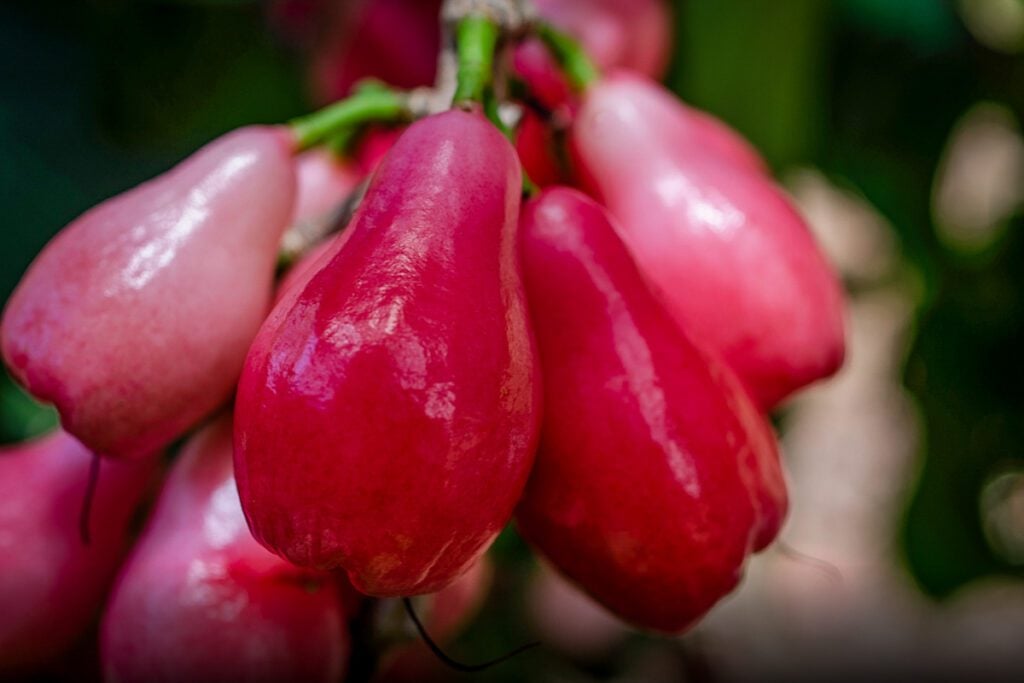
- Name in Hawaii: Ōhi’a ‘ai
- Tastes like: a delicate mix between a watermelon, an apple, and a touch of rose
- Texture: as the name suggests, this Hawaiian fruit is quite similar to that of an ‘average’ apple — crunchy, juicy, and delicious
- Season: June – August
If there was a contest for the most beautiful Hawaiian fruit, the mountain apple would likely win. With its rosy or ruby color and adorable shape, this fruit is the creme de crop of fruits in Hawaii.
Not only is the fruit gorgeous, but when the mountain apple tree blooms, it produces pink, puffy flowers that look like they actually belong somewhere deep in the sea.
Similar to a regular apple, you can eat it whole, but be mindful that there are a few seeds in the middle and many people prefer to peel the thin outer layer first.
In Hawaii, mountain apples are widely popular in the summer and can be found in jams, salads, and of course, raw.
6. Mango
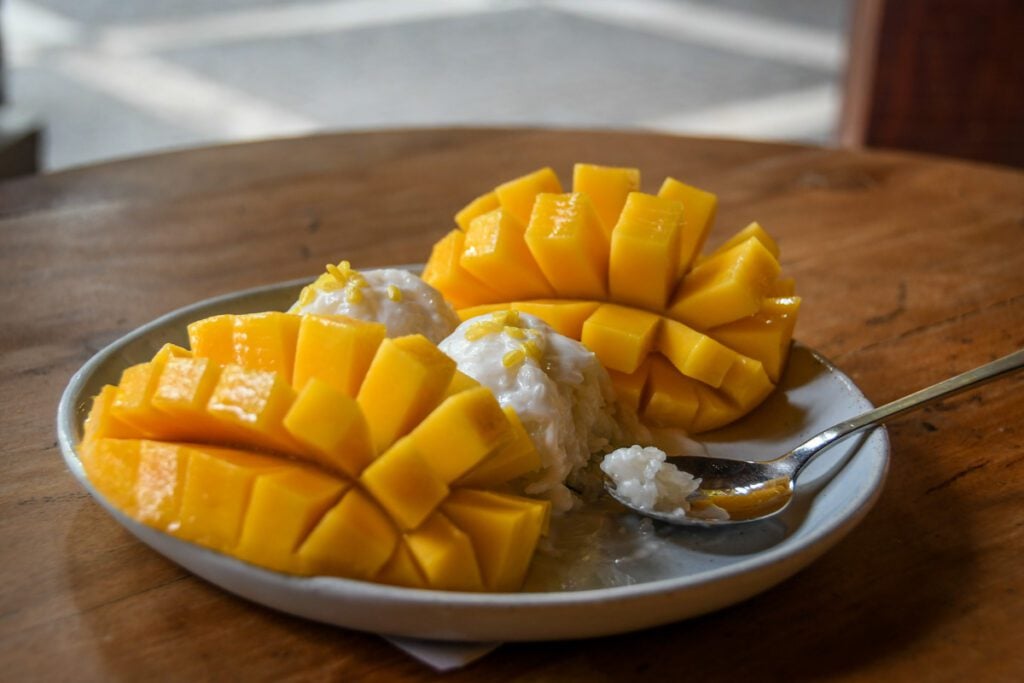
- Tastes like: a sweet and juicy slice of tropical heaven
- Texture: perfectly ripe mangos are as smooth as butter and juicy like a peach
- Season: April – September
Mangos are a popular tropical treat in Hawaii and an absolute must if you’re visiting the islands. Their long harvest season makes them quite popular. They are a staple in farmer’s markets in the spring and summer months.
Although most commonly found in salads or smoothies, mangos add a lovely burst of taste to savory dishes such as salsas or curries.
Feel free to snack on mangos guilt-free as they are high in vitamin C!
7. Noni
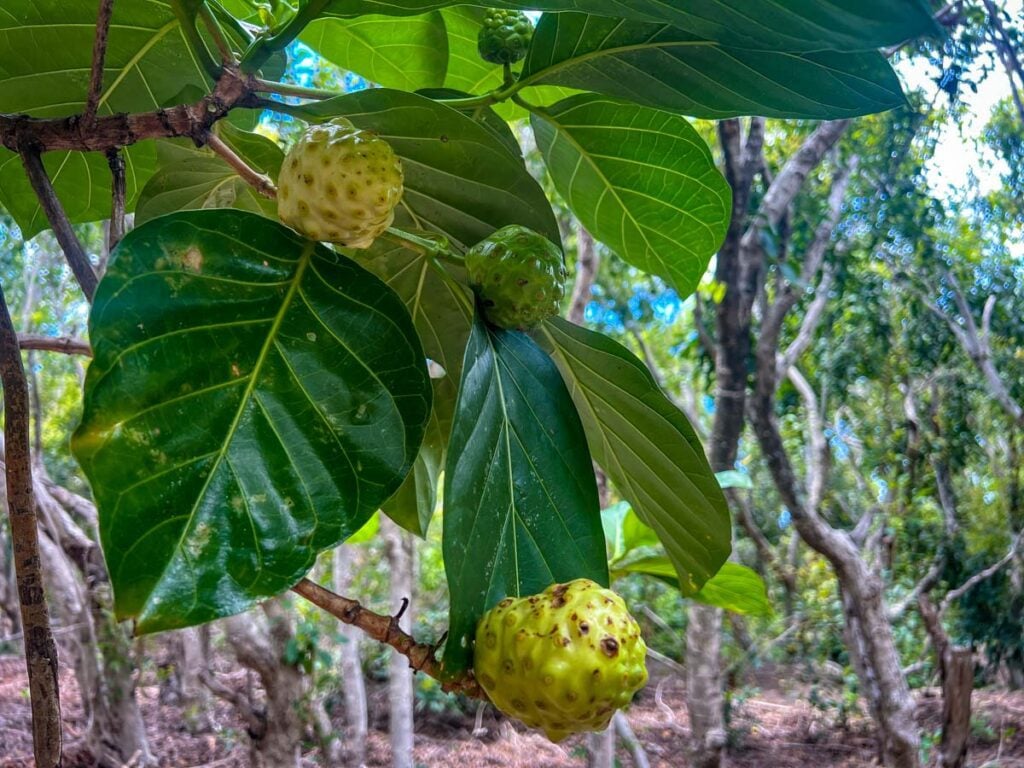
- Tastes like: A strange mix between soil and vinegar … very earthy!
- Texture: somewhat similar to an overripe fruit, noni is squishy and seedy
- Season: year-round
Although an abundant fruit in Hawaii, the odor (reminiscent of damp gym clothes) and harsh taste turn a lot of people off. In fact, noni has even been nicknamed the ‘vomit’ fruit.
With that being said, noni is commonly blended into smoothies (to mask that awful smell) and has insanely attractive health benefits, such as being high in antioxidants and aiding in both pain relief and digestive issues.
We don’t think you’ll want to try this fruit on its own, but it makes for a good truth or dare adventure!
8. Lychee
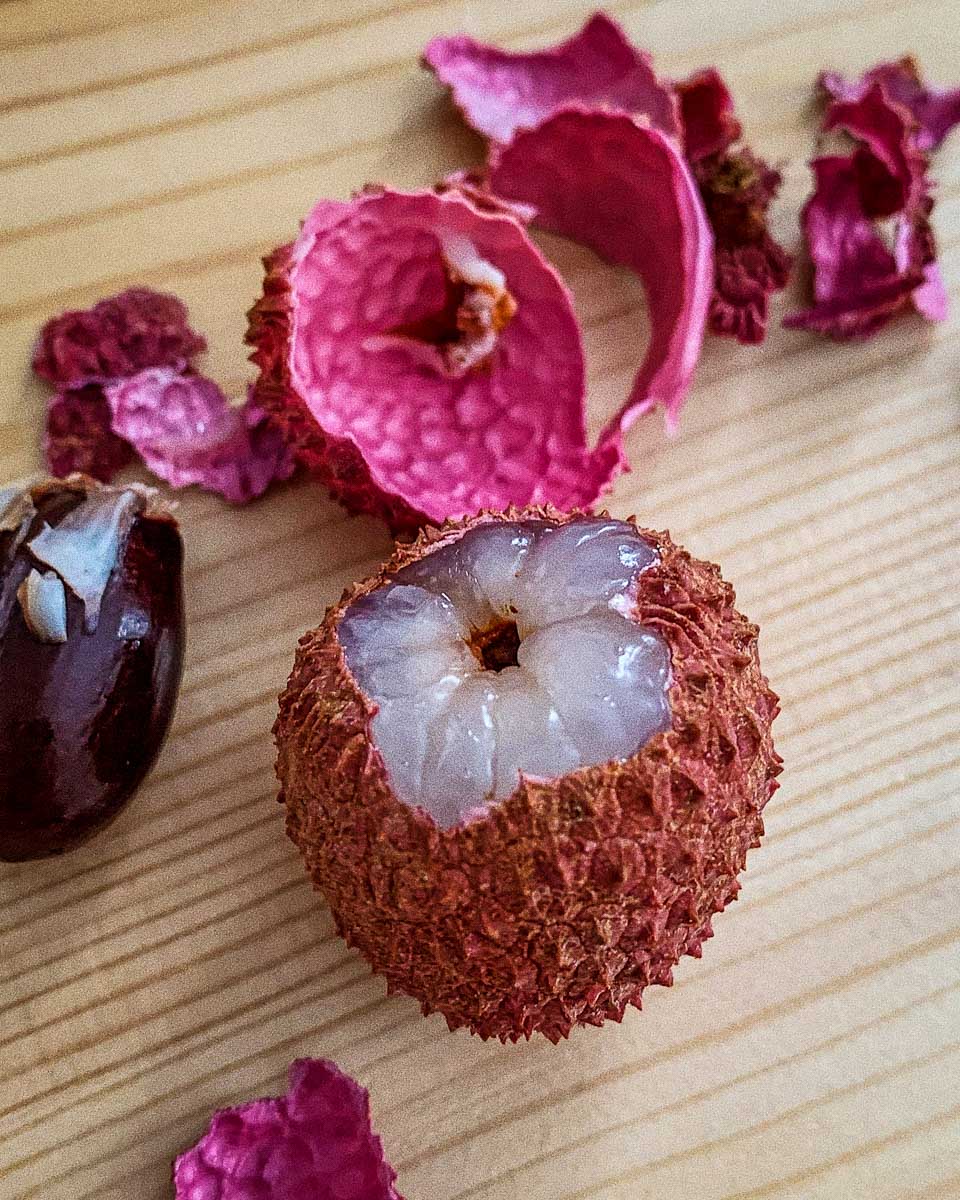
- Tastes like: a dollop of tropical goodness: a mix between grapes and strawberries with a burst of citrus
- Texture: after you peel away the brittle skin, lychee is quite similar to a grape in texture
- Season: May – September
Lychee is tasty no matter where you enjoy it, but it seems, somehow, extra fresh and juicy in Hawaii.
After you peel back the hard exterior, lychee is quite similar to the taste and texture of a grape, but quite a bit sweeter. Be careful to eat around the hard pit in the middle.
You can easily find bundles of lychee in roadside markets or infused in cocktails, desserts, or fruit salads.
Tip: This is a really easy fruit to pack if you’re beach hopping or hiking because it won’t make a mess in your bag and is a delicious way to hydrate.
9. Guava
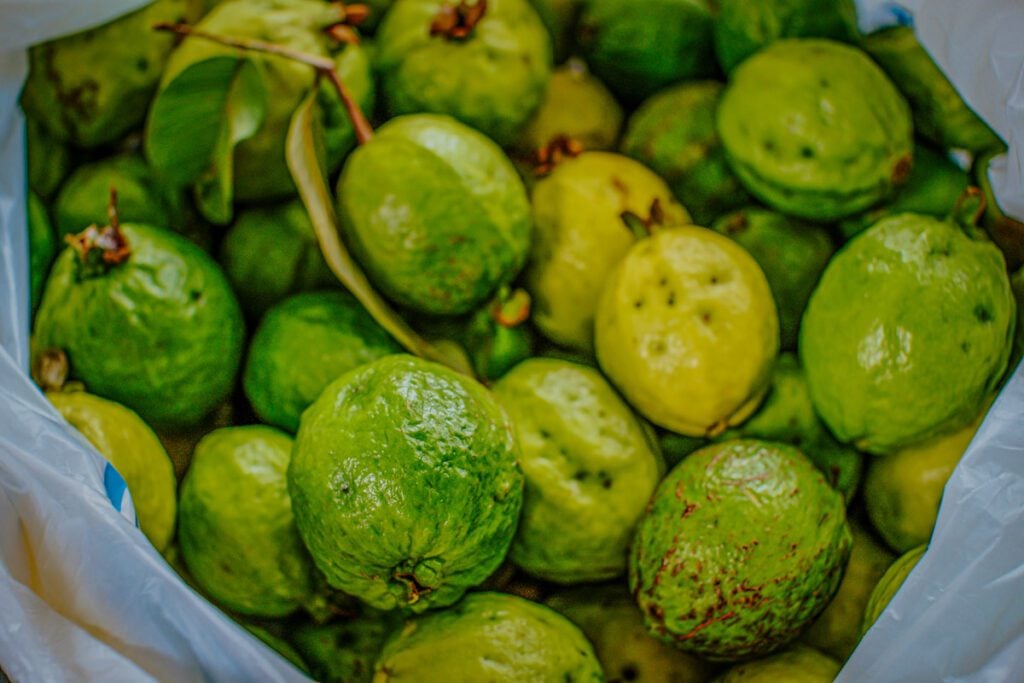
- Tastes like: a medley of sweetness, you’ll taste a combination of pear, apple, and strawberry
- Texture: fairly soft (like a peach) with edible seeds
- Season: July – December
When guava is ripe, it offers a lovely floral fragrance, which is a great indicator of whether they are ripe or not.
There are different guava varieties in Hawaii. Strawberry guava (see below) is known for its sweetness, while the taste of white guava resembles that of an apple.
Although some people prefer to peel guava before eating it, the rind is actually super high in vitamin C. The choice is yours!
10. Apple banana
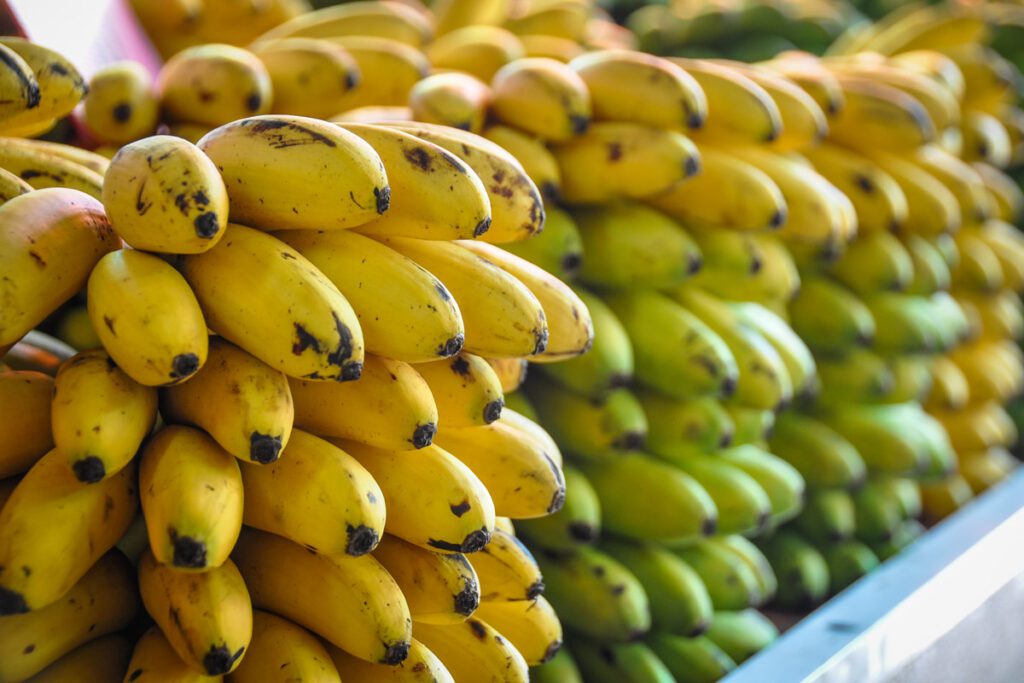
- Name in Hawaii: Hawaiian banana
- Tastes like: a tangier (and tinier!) take on your standard banana
- Texture: similar to a regular banana except less mushy
- Season: year-round
Due to their adorable and compact size, apple bananas are the perfect Hawaiian fruit to snack on. Simply add them to your backpack or beach bag before heading out on an adventure.
Apple bananas are abundant in Hawaii, so you won’t have a difficult time finding them around the islands. But beware as they are quite addictive — some people say they are far superior to regular bananas. We’ll let you be the judge.
If you have a sweet tooth, we think you’ll love banana lumpia! It sounds a bit eccentric, but this traditional Hawaiian dessert consists of apple bananas wrapped in spring rolls then deep fried until crispy. Often, this dish is served with warm caramel drizzled across the top. So, not the healthiest option, but hey, when on holiday…
11. Papaya
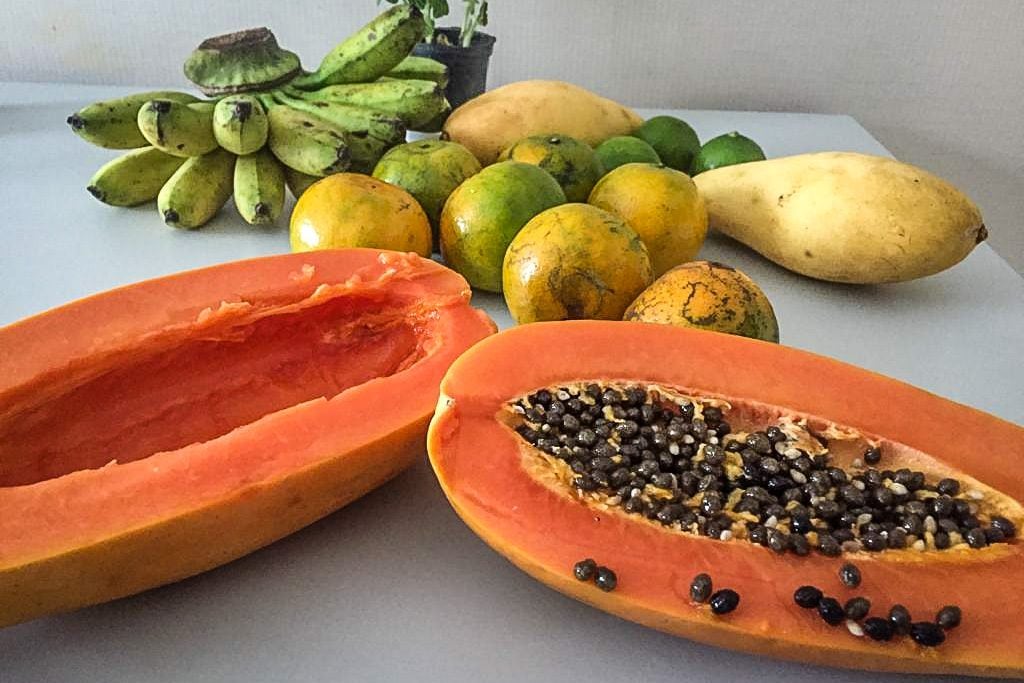
- Tastes like: a melon, but a touch less sweet
- Texture: fresh papaya is very tender and almost has a creamy or buttery texture
- Season: year-round
Papaya is a vibrant and refreshing fruit from Hawaii that makes for a perfect standalone snack. Sooo good.
To eat it, slice the papaya in half, remove the seeds in the middle and scoop out the fruit.
While the seeds in the middle are edible, they are quite strong (like pepper) and are often used for salad dressings. If you don’t mind the strong taste, it is worthwhile to try a few due to their incredible health benefits.
Insider Tip: Squeeze a lime over your papaya for the best flavor combination. This is the only way we eat papaya now!
12. Rambutan
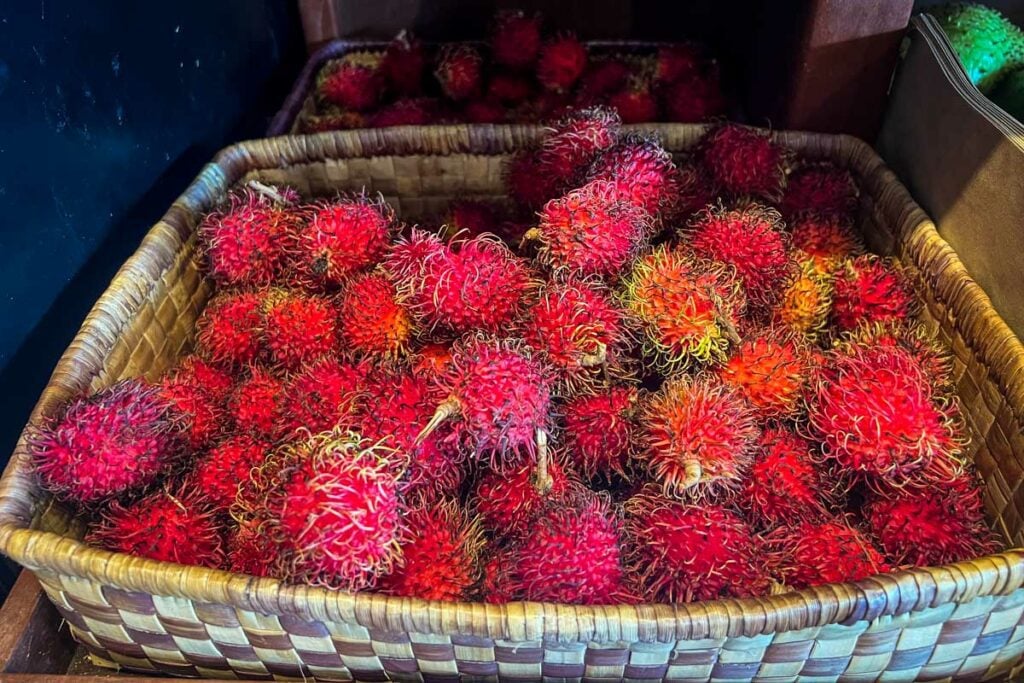
- Name in Hawaii: Longan
- Tastes like: wholly sweet, sour, and satisfyingly juicy
- Texture: protected by a hard, hairy case, the inside is squishy like a grape
- Season: December – March
Rambutan is quite similar to lychee in that they both have a vibrant-colored exterior that you have to peel away to get to the fruit. The most distinct difference is that rambutans are covered in wiggly, spiky hair (and honestly, they are quite adorable).
Unless you’re a fruit connoisseur, it might be difficult to determine the difference in flavor between lychee and rambutan, but many say rambutan is typically sweeter and juicier than its cousin.
Be mindful to eat around the tough pit in the middle.
Similar to lychee (see above), this is a great snack to pack on a hike. The hard exterior will keep the fruit safe in your bag and it’s easy to transport.
13. Mangosteen
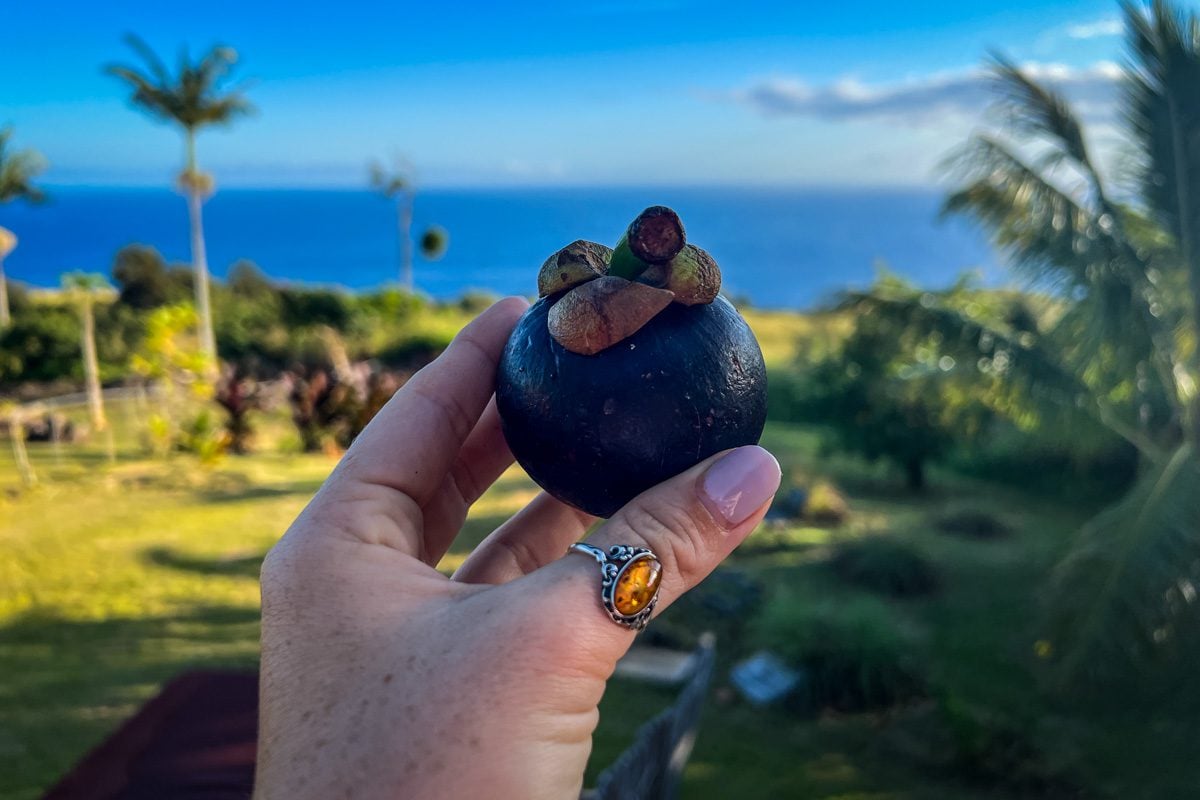
- Tastes like: a delightful cross between a mango, pineapple, and strawberry
- Texture: similar to the texture of a mango or peach, with some small pits
- Season: winter months
This is my all-time favorite fruit! Native to Southeast Asia, I became obsessed with mangosteens when I first tried them in Thailand back in 2011, and I’ve been on the hunt for them ever since.
Mangosteens have a relatively short season and only grow in very specific regions of the world, so if you see these beauties while in Hawaii, do yourself a favor and try one (or 10!).
With a deep purple exterior, you will peel them, similar to how you’d peel an orange (though the skin is much thicker and a different texture).
Once you get the inedible skin off, you will see a sectioned fruit that resembles the sections of a clementine. However, the texture is not like citrus, but instead is similar to that of a mango. Be careful when you bite in because some sections have small, hard pits.
Not only are they delicious, mangosteens are known to have a variety of health benefits, like preventing heart disease and improving digestion, just to name a few.
Fun story: One time Ben and I ate 2 kilos of mangosteens (yes, you read that right!) in less than 24 hours because we couldn’t bear to throw them away before our flight!
14. Dragonfruit

- Name in Hawaii: pãniniokapunahou
- Tastes like: a blend between a peach, kiwi, and a pink starburst
- Texture: due to the numerous seeds, this fruit is mildly crunchy
- Season: July – October
Dragonfruit thrives in warm, sunny climates, making it one of the most popular fruits in Hawaii.
Not only does dragonfruit look quite unique with its vibrant hues and hairy spikes, it also has an interesting origin, as it comes from a cactus that blooms under the light of a full moon. How cute is that?
When eating this fruit, discard the exterior and focus on the sweet insides which are sprinkled with little black seeds, kinda like a kiwi.
You’ll know a dragonfruit is ripe if it’s firm and brightly colored.
15. Starfruit
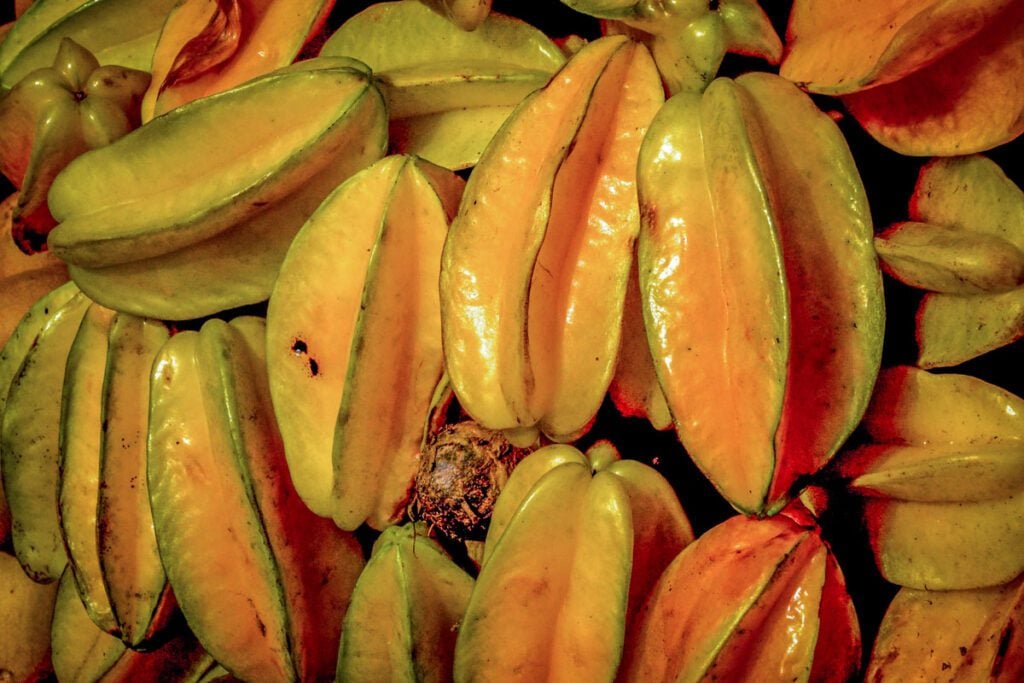
- Name in Hawaii: nicknamed five fingers
- Tastes like: a burst of paradise that’s both tangy and sweet
- Texture: crunchy on the outside, juicy on the inside
- Season: September – January
If you’re looking to sample a lot of exotic fruits on your trip to Hawaii, starfruit should be near the top of your list. This versatile fruit, which isn’t as popular on the mainland, thrives in Hawaii.
You can recognize starfruit from the five distinct valleys that run along the sides. As the name implies, when sliced crosswise, the fruit resembles a mini-star, making it both a delicious and visually alluring addition to fruit salads and desserts.
16. Soursop
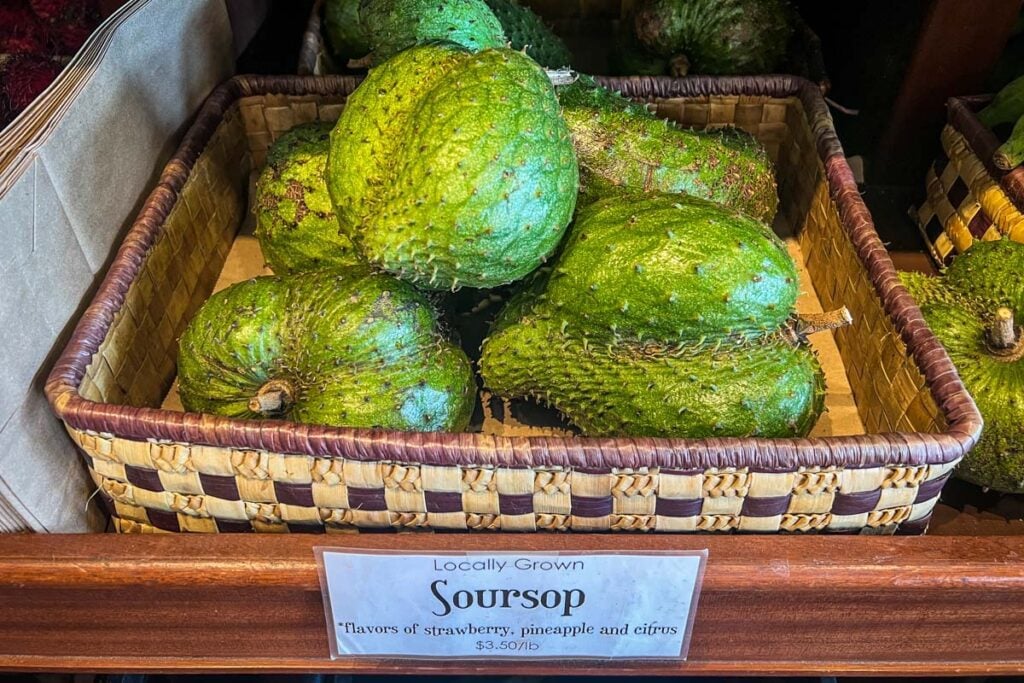
- Name in Hawaii: graviola
- Tastes like: a tangy combination of pineapple and strawberry
- Texture: similar to the texture of custard, creamy and velvety
- Season: June – August
Due to its creamy texture, soursop is often used in juices, smoothies, teas and even ice cream. Simply pop by any exotic fruit stand and we can pretty much guarantee soursop will be on the menu in one form or another.
Although the strange exterior — green and bumpy — looks daunting, soursop can be eaten raw, too. Simply scoop out the meat and discard the outer layer and seeds.
It has an interesting medicinal background, too, and is said to treat inflammation and increase levels of vitamin C.
17. Strawberry guava
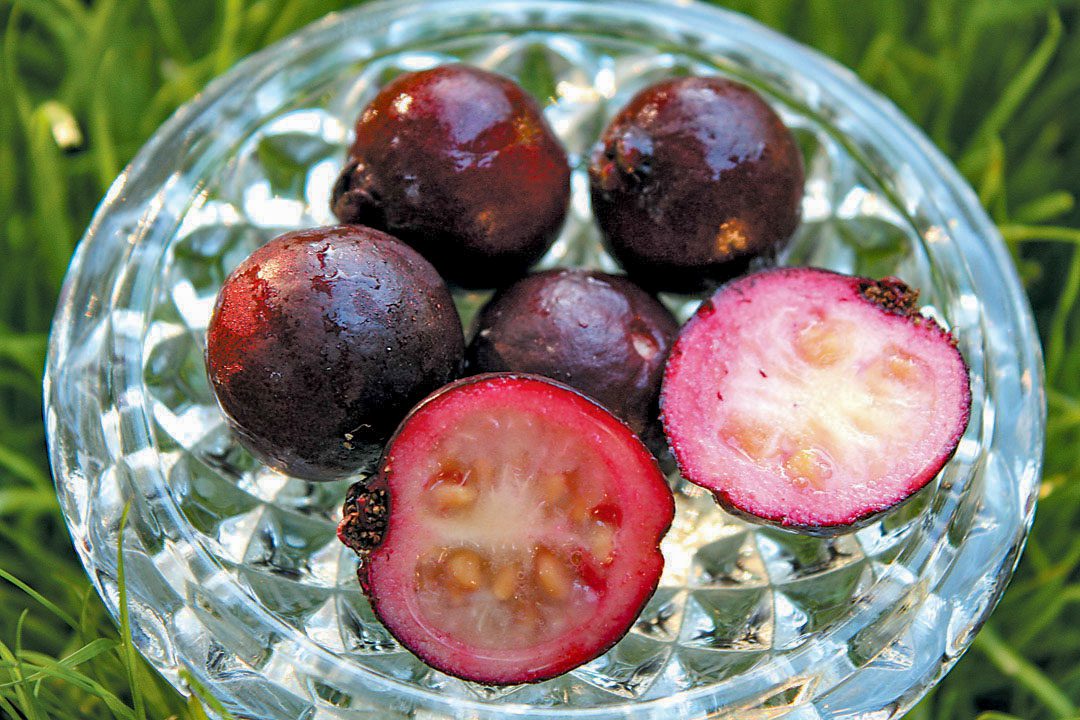
- Name in Hawaii: waiawī
- Tastes like: quite similar to a plum and strawberry, very juicy, but with hints of spice
- Texture: juicy and delicate
- Season: July – December
This beloved Hawaiian fruit is absolutely delightful when used in jams, smoothies and desserts across the islands.
To eat this fruit, simply pop it in your mouth like a grape! If that isn’t your thing, you can easily spit out the seeds and peel off the skin — though both are edible, if slightly bitter.
Strawberry guava are typically much sweeter than their cousin, the white guava.
Looking for a really exotic taste? Try sprinkling chili flakes over strawberry guava. Yum!
Hawaiian fruit seasons
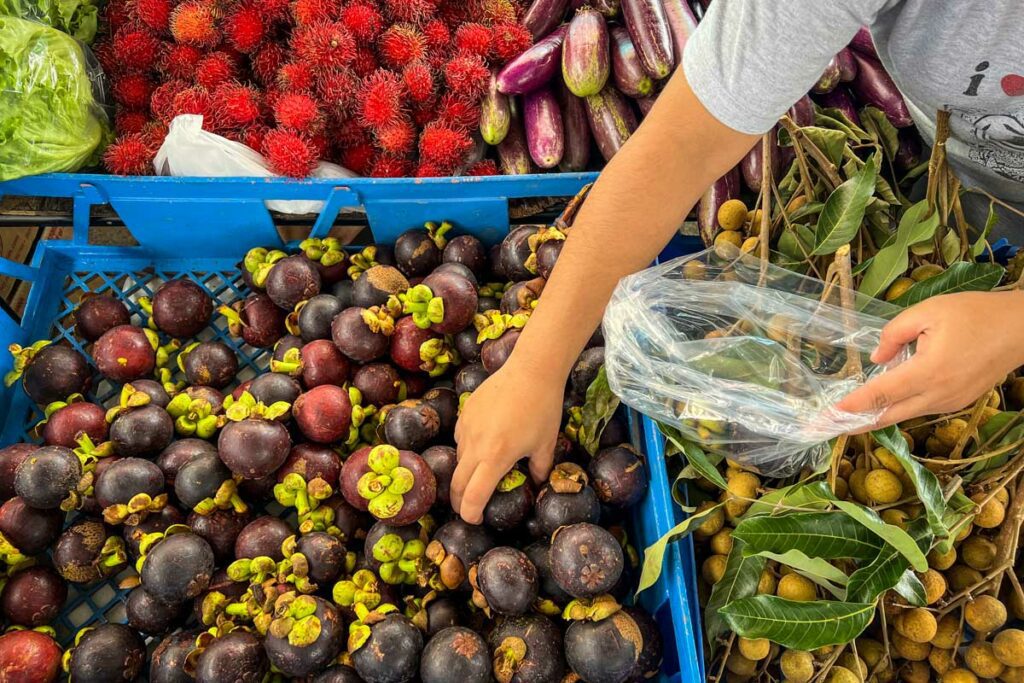
Wondering what types of fruit you’ll be able to find on your trip?
Below we break down the typical seasons for some of Hawaii’s most popular fruits.
Year-round
- Apple bananas
- Coconuts
- Noni
- Pineapples
Spring (March – May)
- Lychee
- Mangosteen
- Papayas
Summer (June – August)
- Dragonfruit
- Lychee
- Passionfruit
- Soursop
Fall (September – November)
- Breadfruit
- Dragonfruit
- Passionfruit
Winter (December – February)
- Mangosteen
- Breadfruit
- Rambutan
FAQs about Hawaiian fruits
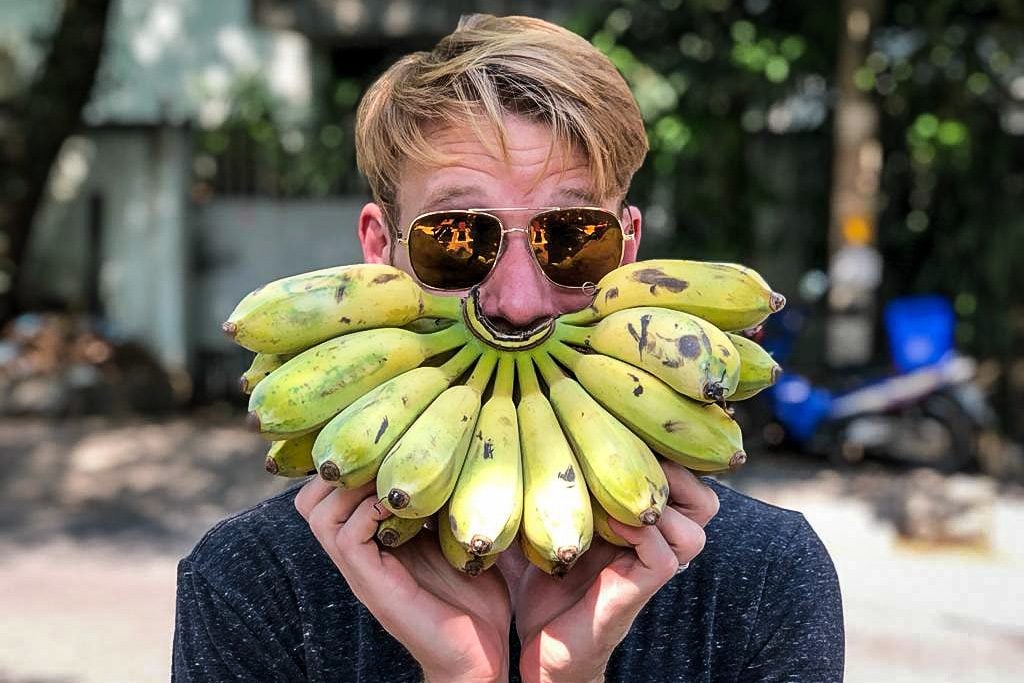
Have some questions about Hawaiian fruits? We’re here to help!
Which fruits are native to Hawaii?
When you consider the variety of fruits that are offered in Hawaii, it is a bit shocking to discover that the majority of all fruits were actually brought over by settlers and have since thrived in Hawaii.
Where to buy Hawaiian fruits
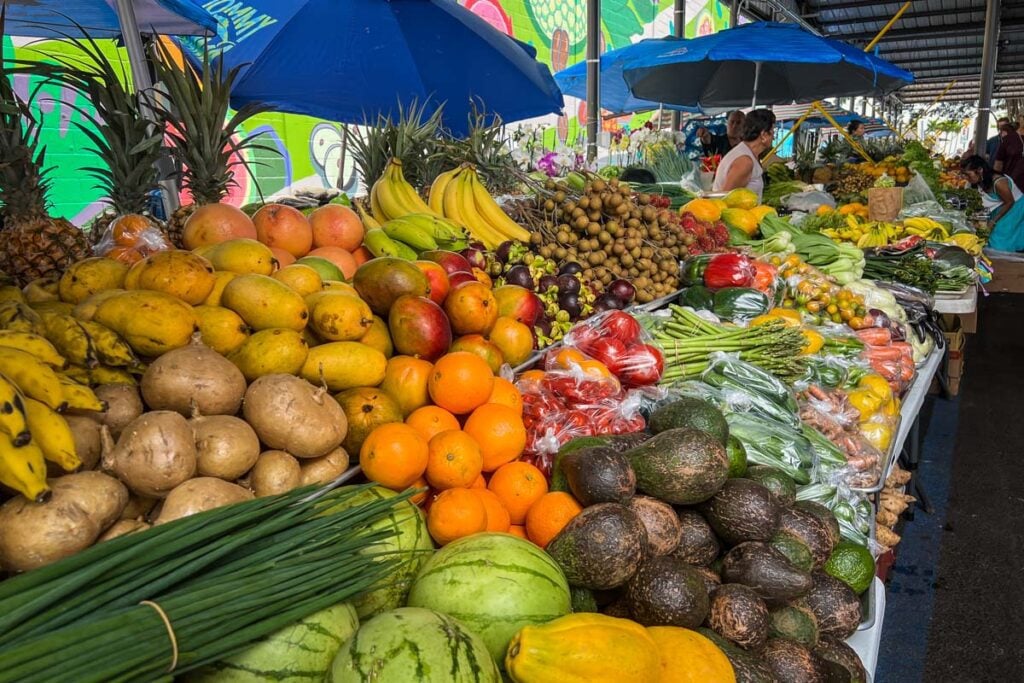
You can purchase fresh Hawaiian fruit at local grocery stores, farmer’s markets, or roadside fruit stands nearly everywhere across the islands.
When you arrive, we recommend asking your hotel or airbnb host for a farmer’s market near you. They happen all the time around the islands and are your ticket to some of the freshest fruit.
Can I bring fruit home with me on the plane?
There are strict rules against bringing fruit from Hawaii to the mainland and it probably isn’t the best idea — especially if you’re looking for a smooth day of travel.
If you choose to travel with fruit, double check the USDA requirements and prepare to present items to an inspector at the airport.
There are a few fruit items that are permitted to leave Hawaii:
- Fresh coconuts
- Fresh pineapples
- Packed and sealed fruits such as: papaya, dragonfruit, lychee & starfruit
Hawaiian fruit farm tour
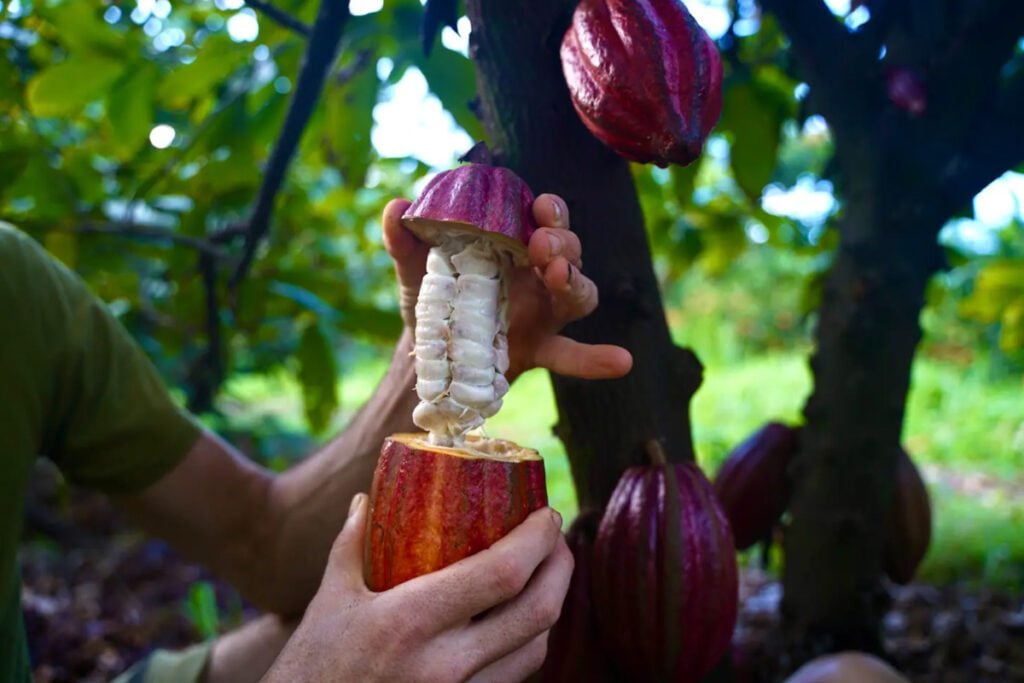
As huge fans of food tours when we travel, we think this Airbnb experience offering a fruit tour in Hawaii makes for a perfect addition to planning your dream Hawaiian vacation.
Prepare for a full sensory experience as you’ll be able to see, smell, touch, and — most importantly — taste a wide variety of organic fruit straight from a local garden. Spanning over 50 acres and housing over 1,000 exotic fruit trees, you can expect to learn a lot about Hawaiian fruits on this juicy tour.
What you need to know:
- Hours: 2 hours
- Price: $95 USD
- Location
What guests are saying:
“Such a fabulous, fantastic, flavorful, fun adventure into all things fruit! Did I mention epic deliciousness! Our farm cruise with Adam and Daria was nothing short of amazing. We loved their passion for growing all the wonderful (and often exotic) fruits, veggies and herbs that nourish our bodies.. but feed our souls. This tour will go on permanent repeat mode for ALL our future trips to Kauai. Mahola” -Anne, March 2023
Plan your trip to Hawaii
After multiple trips to the islands (and already dreaming of our next one!), we’ve put together tons of helpful resources to make planning your dream Hawaii vacation a breeze. Start with our Hawaii Travel Homepage, and be sure to check out these helpful articles:
- First time? Our Hawaii Trip Planner walks you through everything you need to know.
- Wondering how much to budget? This guide breaks down exactly how much a trip to Hawaii costs (and shares money-saving tips!).
- Find out the best (and worst) times to visit Hawaii so you can plan around crowds and weather. (Hint: it’s probably not the time of year you’re thinking!)
- Don’t miss our ultimate Hawaii bucket list filled with epic adventures, relaxing moments & local gems.
- We have a detailed guide to hiking the Kalalau Trail, with all the info you need to plan your backpacking trip!
- Get the best deal and avoid common mistakes by reading our guide to renting a car in Hawaii.
- Curious about vanlife in paradise? These are the best Hawaii campervan rentals (and expert tips for living vanlife in Hawaii!).
Don’t forget to grab your Hawaii Packing list!
Be sure to download our complete packing list for Hawaii! It’s packed with good suggestions and insider tips to help plan your Hawaiian vacation. And it’s completely FREE, so why not!?
Save this article on Pinterest for later!
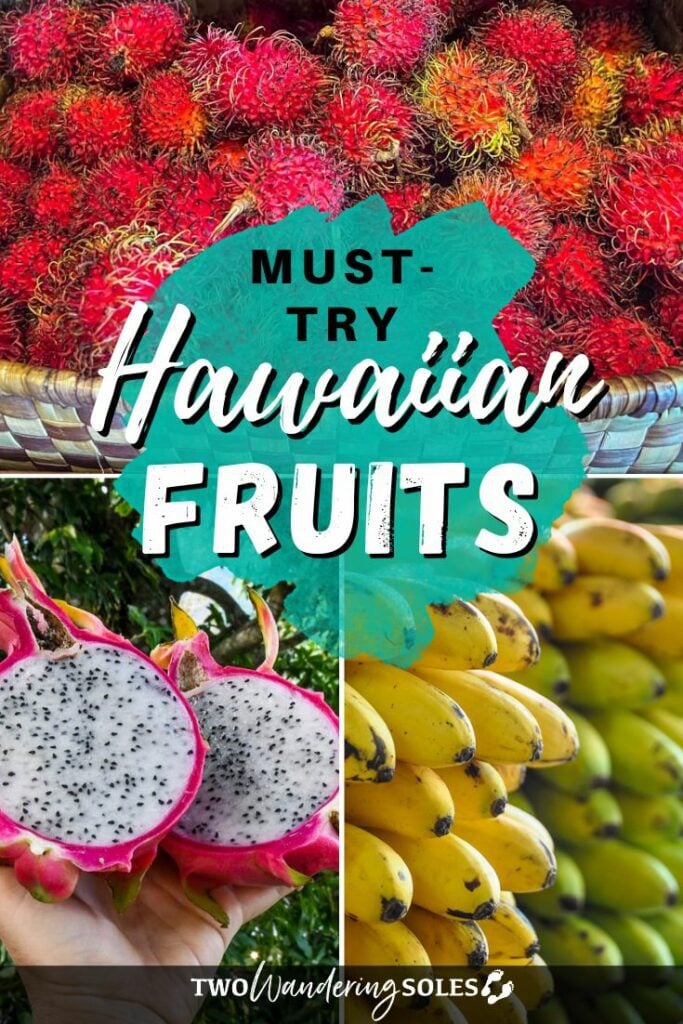
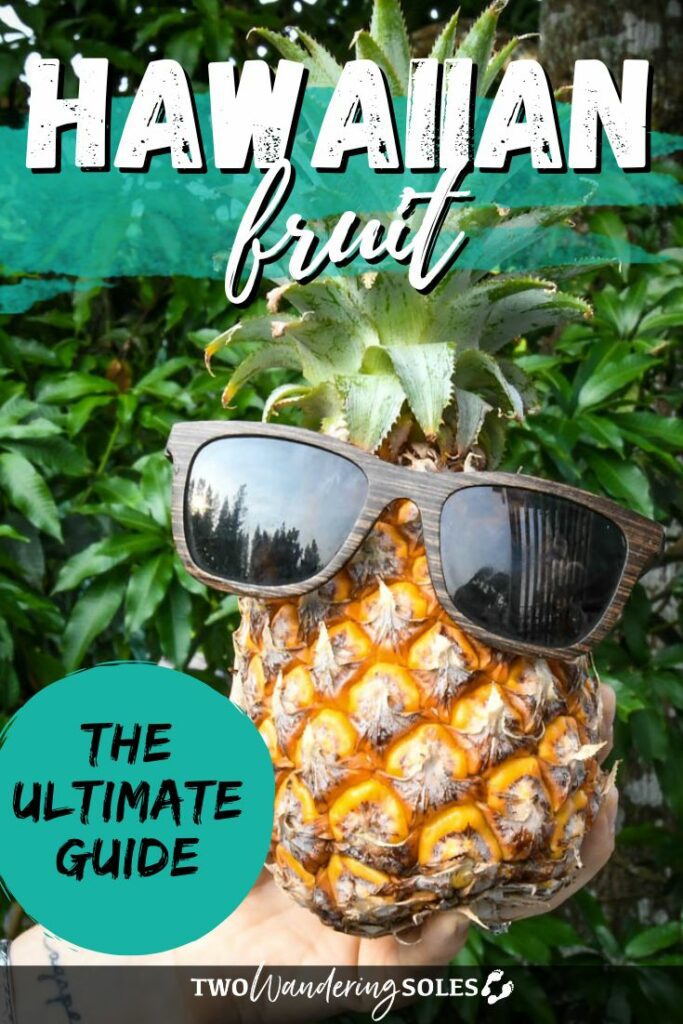
We want to hear from you!
Which of these fruits have you tried before? Do you have more questions about Hawaiian fruit? Comment below and we’ll do our best to get back to you!

